I’ve been round these parts before — in fact, I’ve done a survey of Canarsie’s still-numerous, but dwindling number of alleys before, in 2008 as a matter of fact. However I didn’t get to all of them then, and even after this trip in October 2015 I still won’t have photos of each and every one. I’ve visited Canarsie repeatedly for its odd between-block roadways — the first time was in 1999 when I first began gathering material for the site. Canarsie’s alleys (they’re more than alleys, but I’ll get to that shortly) have not been widely photographed over the years — official city chroniclers ignored them, and there has never really been significant interest or notoriety attached to them. However, the back roads of Canarsie point to its small-town origins…

Here’s an overview of an 1890 map of Canarsie. At this size, you can’t make out individual roads, but bear in mind that on this map, streets that are not yet open are drawn in buff or light brown, while roads that have already opened are drawn in purple. The overall grid has been laid out, but not yet built, while Cnarsie’s original routes from the early 19th Century are already in place, and this can especially be seen in the horizontal purple lines in the map. The three main “vertical” or northeast-southwest roures were the mostly-vanished Varkens Hook Road on the left (the name came from rough Dutch for “pigs’ corner”); East 92nd Street, then a part of Canarsie Road; and Rockaway Avenue, now called Rockaway Parkway. Meanwhile, small yellow rectangles and squares marked buildings, and those were relatively few in 1890 — many were farm buildings or barns.
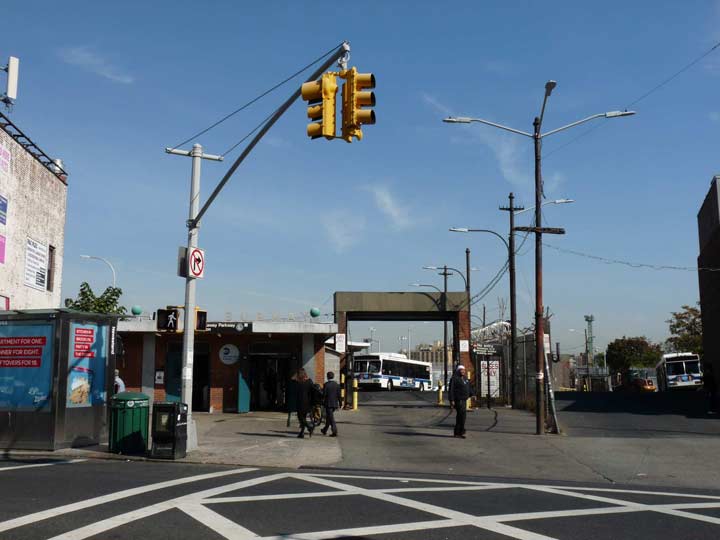
All my Canarsie visits begin at the end of the BMT Canarsie Line, the Rockaway Parkway station. Note the trolley poles with lampposts attached on the left — local trolley routes looped directly to the station entrance, and decades ago the tracks were removed and buses took over. Today you can enter the fare-controlled area upon exiting the bus, since the automatic transfer is “baked-in.”

Other than their being a pain in the neck to remove, I can’t account for the 10-12 or so trolley poles that have been allowed to remain in place at the subway terminal area. This one, on Glenwood Road near Rockaway Parkway, is tilted toward a trolley right of way that ran midblock from the subway to Jamaica Bay. Details on this FNY page.
Truckleman’s Lane
I wanted to check out Truckleman’s Lane, which according to Google Maps runs east from Rockaway Parkway (which stands in for East 97th Street) to East 99th, with another piece at East 100th, running south of Flatlands Avenue. Truckleman’s Lane is easily entered from Rockaway Parkway…
…where you will find a quartet of very old buildings, most overlaid with aluminum siding, except for the fourth, which is derelict and falling apart. It’s impossible to go further, as a gate bars access to East 98th, thus you have to go around the block
and proceed east again from East 98th, where you will once again find a pair of homes on the side of the lane. This likely explains Truckleman’s continued existence.
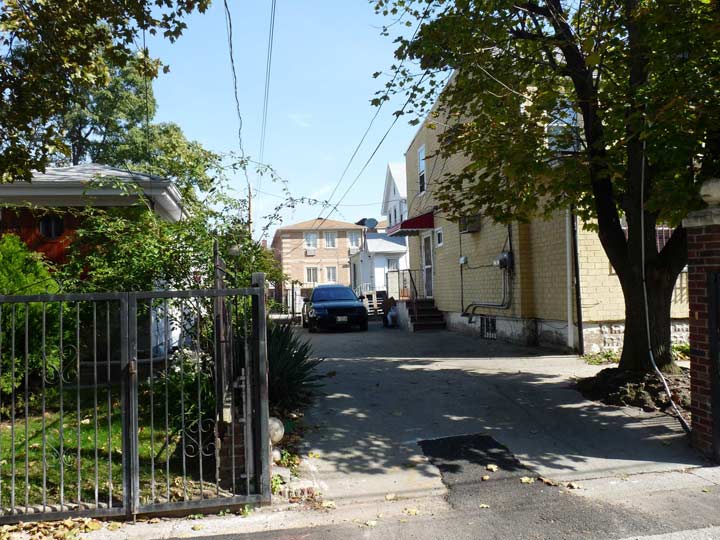
Though Truckleman’s Lane is not gated from East 99th, it seems to clearly be on private property, even though it is a mapped city street as indicated by the presence of Department of Transportation street signs.

Ditto at East 100th, where it is part of a driveway but is on a direct line with the rest of the lane.

This closeup version of the 1890 Canarsie map shows both Truckleman’s Lane and the next lane on my list, Skidmore Lane. In 1890, Truckleman’s was named Battle Row (misspelled here as Battel Row) but it later took on the name of an adjacent property owner, Trochelsmann, and had its spelling somewhat modified.

I have marked Truckleman’s Lane with a red line on this Belcher Hyde atlas plate from 1929. This map gives you a good idea how much of Canarsie Lane was empty and unoccupied at this time except for grassy lots or sand pits, which are even noted on the map. Most of the streets had not yet been built, but Truckleman’s Lane, which was already decades old, had several dwellings scattered along its length.
Skidmore Lane
If you take another look at the 1890 map above, note that Skidmore Lane paralleled Truckleman’s Lane between East 92nd and East 100th Streets, between Flatlands Avenue and Avenue J. Today only a pair of short stretches of Skidmore Lane are still officially mapped, at East 93rd and East 94th. However, there are ways that a trained eye can discern places where old roads used to run.
Writing in the Canarsie Courier, Linda Steinmuller provided an invaluable history of the Canarsie lanes and how they got their names:
Skidmore Lane, which once ran continuously from East 92nd Street to [Rockaway Parkway], between Flatlands Avenue and Avenue J, now ends at East 94th Street and is mostly private driveways. This narrow road is named for Isaac Skidmore, a prominent merchant, who ran a general store that served as a recruiting station during the Civil War. The merchant also served as postmaster, operating a contract postal station out of the general store. The Skidmores were English immigrants and among Canarsie’s oldest families. Other prominent family members include Joel Skidmore, a tax collector for the Town of Flatlands during the 1860s, and John Skidmore, who blew the whistle every time the Canarsie shuttle, trolleys, and buses left the Rockaway Parkway station for the trip to the shore.
There is also a Skidmore Avenue in Canarsie, running west from Rockaway Parkway at the Bay View Houses north of the Belt Parkway.

Strong evidence of Skidmore Lane can be seen on the west side of Rockaway Parkway north of Avenue J, but I stumbled on some interesting items before I got there, such as this broken neon Hot Bagels sign on the Avenue J side…

There’s a remaining scrolled-mast fire alarm signal mounted on a corner telephone pole…

Last but not least, a hand-lettered Cleaners sidewalk sign on the Rockaway Parkway side.
OK, here’s the Skidmore Lane remnant proceeding west on Rockaway Parkway just north of the Canarsie branch of the Brooklyn Public Library. In the rear it leads to a ramshackle, deteriorated garage. From the lane you have a view of a fairly large retirement and rehabilitation home at 1555 Rockaway Parkway.
Skulking north on East 96th between J and K, I saw no evidence of Skidmore Lane but I did see some relatively un-renovated, aluminum siding-free homes that have been here since the early 20th Century.

There’s no evidence of Skidmore Lane from East 95th Street. However, north of where the lane used to run there is a house facing away from the street and a large garden in the rear. This brings to mind the descriptions I had read of Canarsie in books such as the WPA Guide to NYC, which described a number of produce farms in the neighborhood. Perhaps I stumbled on the remnants of one.
However, the lengthwise placement of the house may have more to do with the fact that it bordered the right of way of the trolley to the waterfront I mentioned earlier. It ran between East 95th and 96th Streets and can be seen clearly on this 1929 atlas plate.
On East 94th between Flatlands and Avenue J is finally a reliable clue, an actual street sign. What it identifies is in question. It’s placed in front of a driveway on the east side of the street, but there’s a much wider driveway on the west side that looks as if it could have been a road, so I’ll go with that.
Another street sign at East 93rd, and an actual Skidmore Lane, and this piece actually has an actual address, #111 Skidmore.

There are only two remaining addresses on Skidmore Lane. Returning to the Belcher-Hyde 1929 atlas, I’ve circled them in red, #111 and further south, #93. Note that at this relatively late date, Avenue J hasn’t even been built and there are still some buildings in its right of way!
There is also a dead-end section of Skidmore Lane on the east side of East 92nd Street, once one of Canarsie’s main north-south routes; many of the older roads intersect it. The piece is gated off, but I was able to get a good look at it by shooting through the chain link fence. At the east end of the dead end is #93 Skidmore Lane. It alos shows up nicely in the Google Street View overhead tilted angle.
Holmes Lane
Holmes Lane runs for a little more than one block from East 95th to beyond East 96th Street. Although it has been marked by street signs in the past, it’s absent them now; perhaps it is awaiting a set of new Cleartype signs. However, when a street isn’t officially mapped by the city it doesn’t receive street signs, so that may be the case here. Holmes Lane has one telephone-pole mounted lamp, and when I “discovred” it in the mid-1970s, it was so out of the way that the lamp was a crescent-moon shaped incandescent light on a scrolled mast! I wasn’t carrying a camera in those days, oh well.
According to Linda Steinmuller, Holmes Lane is still a dirt road that runs from East 95th to East 96th Street between Avenues K & L. The earliest Holmes listed in the Canarsie directory, Emmanuel Holmes, was as a fisherman. Rev. Jeremiah Holmes founded the Plymouth Congregational Church in 1880. At the time, the church was on East 92nd Street, between J and K, and was known as St. Paul’s Congregational Church. In 1892, it was renamed Plymouth Congregational Church and was relocated to Rockaway Parkway and Baisley’s Lane when Rev. Samuel Silkworth succeeded Rev. Jeremiah Holmes as the pastor.
(Baisley’s Lane was another old Canarsie road that has left no trace; it ran from East 95th to Rockaway Parkway south of Avenue J. Presently its space is occupied by Canarsie High School.)
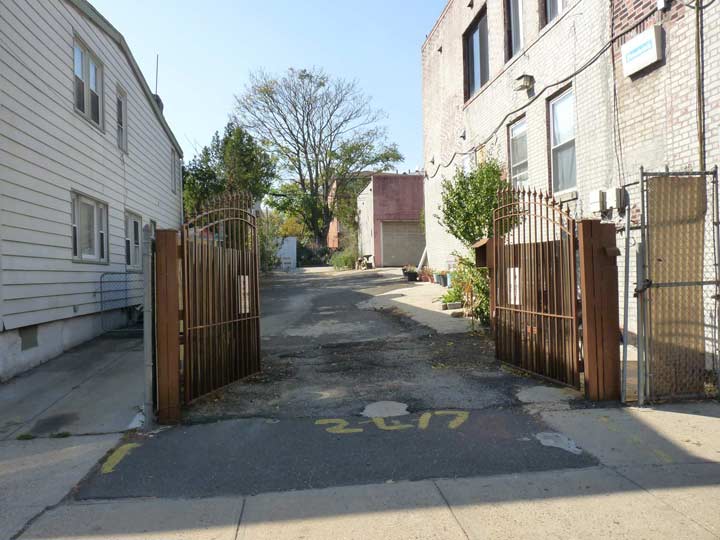
This is the former intersection of Holmes Lane and Rockaway Parkway; it’s an especially wide driveway between a private home and an apartment building.
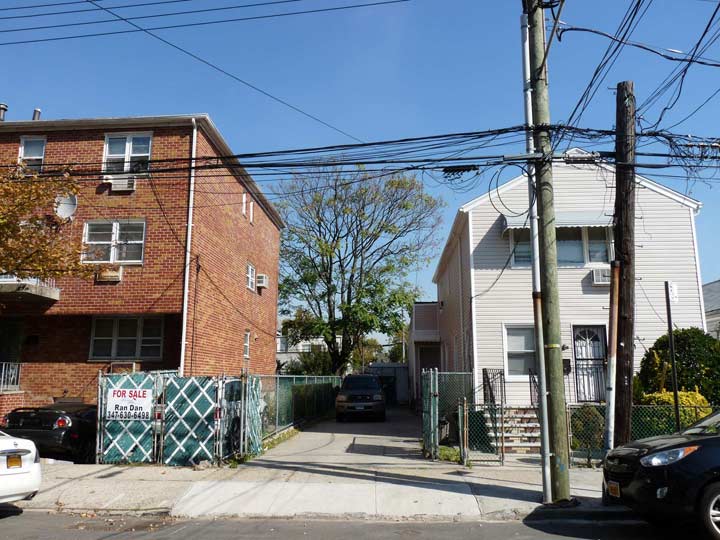
This is a remnant of Holmes Lane looking east from East 96th Street.

Holmes Lane looking west from East 96th. It’s a rarity these days in Canarsie in that you can walk from one end to the other without encountering a locked gate.

This is the single streetlamp I was talking about.
There are about a half dozen homes scattered along Holmes Lane’s north side. There are a variety of house numbering schemes: there’s a #9511, but also a #5 and a #7. This situation happens on a few one-or two- block out of the way streets in NYC. My guess is that the original houses kept their old numbers, while newer ones get the 95XX numbering.

I was also surprised to see a row of bungalow-style dwellings on East 95th Street opposite Holmes Lane. These can be seen more often in places like Sheepshead Bay or Gerritsen Beach, where they seem to be dying out and are replaced as soon as their owners sell or pass away.

Looking at Holmes Lane from East 95th. Linda Steinmuller refers to it as unpaved (I seem to recall it like that) but it now has a modern pave job that includes a speed bump.
Stillwell’s Place
The name “Stillwell” is prominent on old Brooklyn property maps, and in the modern era, the name survives primarily on the avenue that forms the spine of Coney Island and where the beloved Nathan’s is located. However the Stillwell name was also prominent in other parts of Kings County:
Stillwell’s Place [runs] from East 87th Street to Remsen Avenue, between Avenues K & L. (It becomes Stillwell Place off Remsen Avenue). The Stillwell family settled all over Brooklyn, but was prominent in Coney Island where a main thoroughfare is named for them. According to Ira Kluger, co-president of the Canarsie Historical Society, there are no records of which particular Stillwell the alley is named after. It should also be noted that Lester Stillwell co-founded the Canarsie Courier in 1921. –Linda Steinmuller in the Canarsie Courier
According to Brooklyn by Name (Leonard Benardo and Jennifer Weiss, 2006 NYU) the first Stillwell in Brooklyn was British immigrant Nicholas Stillwell (1603-1671), who arrived in Brooklyn by way of the Netherlands, owned a large farm in the Gravesend area, but wound up on the ill-fated Dutch side when the British arrived to claim New Netherland in 1664. Nevertheless, the Stillwells remained in Kings County. Descendant Joseph Stillwell, Gravesend town surveyor in the 1860s, was bribed by developers William Engemen and Austin Corbin to permit them to build large seaside hotels in the Sheepshead Bay and Oriental Beach areas.
Although it’s Ms. Steinmuller’s opinion that the two spellings of Stillwell’s Place are deliberate, I disagree, since I’ve seen enough misspellings on Department of Transportation signs to speak knowledgeably on the topic. I suspect that “Stillwell’s,” with the apostrophe, is correct, since I’ve seen it spelled that way in early 20th Century Brooklyn street directories such as the indispensable Little Red Book published by Geographia Maps. In any case it is unusual to see an apostrophe in a DOT sign … in other cases, like Elderts Lane, they don’t bother with one.
Google Maps, hedging bets, has both spellings!
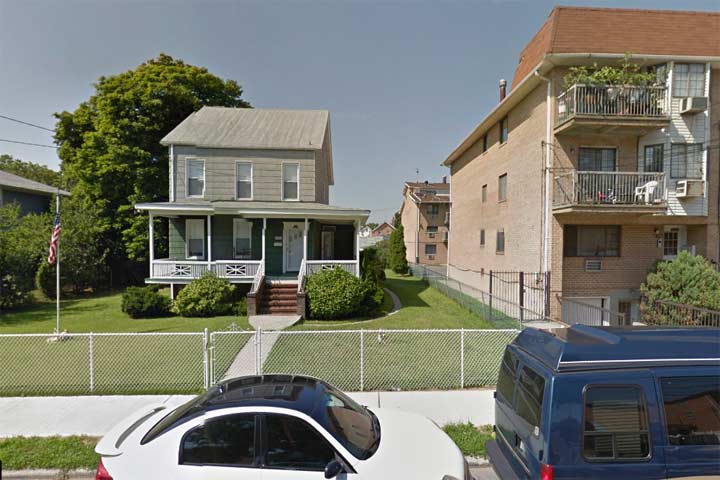
Before talking about the section of Stillwell’s Place that’s still plainly evident, I want to mention that according to the Belcher-Hyde 1929 atlas, it once extended as far east as East 92nd Street, which made sense, since this was once one of the only north-south Canarsie routes. Using Google Street View to search for traces, I found a relatively wide break between buildings on East 92nd Street’s east side at #1372, which appears to be one of the older buildings in Canarsie. The house does have a particularly wide lawn, which may account for the extra space. However, the atlas shows that Stillwell’s Lane intersected East 92nd at about where #1380, a postwar building, is now. But, this goose chase did lead me to a particularly evocative little building.

As it turns out, Stillwell’s Place, seen here looking west from Remsen Avenue, is one of the better-preserved of Canarsie’s old roads, and runs 3 whole blocks from Remsen west to East 87th. There are no locked gates stopping one from idling down its entire length uninterrupted. It’s necessary to do that to get photographs, as the Google Street View truck never did make it all the way there.
Stillwell’s Place, seen from East 89th Street. West of 89th, Stillwell’s has a pebby surface, rather than paved, and is not illuminated by Department of Transportation streetlamps, but it is marked by DOT street signs. In Holmes Lane the reverse is the case.

1890 atlas view of Stillwell’s Place, which is the thin purple line issuing west from East 92nd Street (I have helpfully marked Stillwell’s Place and Holmes Lane). Today the lane only exists west of Remsen Avenue. Some of the dwellings along the lane, marked by yellow boxes, are still in place and that’s what has likely saved the lane over a century later.
Also note carefully that the roads in purple are the only ones yet laid out in 1890, making East 92-95th Streets among Canarsie’s oldest. Also note the Long Island Rail Road tracks running north to south. This was a steam railroad to Jamaica Bay that later became a trolley connection at Rockaway Parkway. The trolley line closed in 1942.
Along Stillwell’s Place. These homes are likely 19th-Century vintage yet they have been sufficiently modernized and aluminum sided to pass for modern buildings.

East 87th Street and Stillwell’s Place, where a black cat crossed my path, but there was no effect since my luck is perpetually bad!
Beach Place
Beach Place is so obscure it doesn’t make most of the printed maps, but Google Maps, which is unhindered by local politicians, developers or planning boards, duly indicates it, a semiprivate, pedestrian-only alley between East 88th and 89th Streets, south of Stillwell’s Place.
An aside: I was continually frustrated by Hagstrom Maps, which beginning in the 1940s and running into the 1970s, showed entire grids of streets and neighborhoods in Staten Island, especially the South Shore area, that simply weren’t there! It seems that one agency or the other had those streets on their drawing boards, but construction hadn’t even started when the maps were printed. Some of these streets never appeared and others only turned up decades later. One would have hoped that street maps reflect conditions as they are, but as I’ve said, politics plays a part in everything.
In the 1970s, Geographia helpfully published editions that had all the planned Staten Island streets, but with the ones that weren’t yet build grayed out.
Beach Place was likely a mid-20th Century development and so is a different beast than the other farm to market Canarsie lanes that have survived over time.
To get to the next group of Canarsie lanes I wanted to inspect, I headed south on East 92nd Street, which as Canarsie Lane was one of the original roads to penetrate this part of the Kings County map. It’s not completely parallel to other streets in the grid and at Avenue M, East 92nd Street reverts to its original name and becomes Canarsie (Road), with East 92nd resuming for one block at Avenue M.
Though its exterior has been renovated in recent years, heavy on the aluminum siding, Grace Church (now known as Church At The Rock) on East 92nd Street just south of Avenue J, is a Canarsie touchstone and a beloved local landmark, likely Canarsie’s tallest building other than the Bay View apartment towers. The Methodist Protestant Church of Canarsie, since renamed Grace, was founded in 1839. I’m unsure when the present building was erected.
The church also borders one of Canarsie’s 19th Century lanes, at first called the Road to Lott’s House and then Church Lane; I discuss it on this FNY page.
Schenck Place
The Dutch name Schenck, or a variant spelling, Schenk, turns up repeatedly on the current Brooklyn street map and also on property maps going back to the colonial days. According to the Canarsie Courier‘s Linda Steinmuller, Schenck Place runs from Canarsie Road to East 91st Street, between Avenues M & N, and was named for Dutch landowner James Schenck. He had a house in what is now Canarsie Beach Park (also called Seaview Park). In 1929, that house was dismantled and moved to the Brooklyn Museum. Schenck was among the victims of “The Canarsie Riots,” which occurred in the 1850s when he was severely beaten and robbed of a valuable watch.
Schenck Place is one of the pleasanter of Canarsie’s old lanes to wander into, and is unguarded by a locked gate on either end. The DOT supplies both street lamps and identifying signs.

Schenck Place’s residences use both old-style and new-style house numbers. For example this is #8 Schenck…

… while the house across the street is #9114 Schenck!
A pair of one-block streets issue from Canarsie Rod east to East 94th Street between Avenues M and N. Both had appeared on area maps by the 1920s. Rost Place features modern tract housing with a couple of veteran buildings from earlier on the 20th Century, and one of the properties has some poplar trees for some spice.
Kaufman Place’s dubious claim to fame is that it began as Grand Place when it was laid out, but had acquired its present name by the 1920s, likely for a local landowner or luminary.

As befitting one of the older roads in the neighborhood, Canarsie Road has some classic early-20th Century buildings in this stretch, even though their owners have sullied them with white brick walls, rusting fences and cheap sculpture.

Eclectic, mini-Queen Anne at Canarsie Road and Mathews Place, the last of the Canarsie lanes to be reviewed on this trip.

Mathews Place has but one “t” but don’t tell the Departtment of Ttransporttattion. The new street sign in Cleartype at Avenue N is similarly misspelled.
Mathews Place
Mathews Place with one “t” is a rarity among NYC streets in that it is L-shaped, which only a few streets in the five boroughs can boast. I can think of a couple offhand such as Welling Court in Astoria, Spencer Place on the Bronx-Yonkers line and Delancey Place in Morris Park (Bronx). I’m sure there are a few more, but only a few.
The narrow lane was in place by the 1920s. Linda Steinmuller: …one of the few [streets] in the city that changes direction abruptly, was named for John Matthews, who was a justice of the peace. Judge Matthews presided over the trial of farmer John Redfern, who owned 150 pigs and 150 cows , which was a violation of the day’s health code that permitted each resident to own a maximum of five pigs and five cows. Redfern was later accused of feeding swill to the cattle, and selling diseased meat.
Mathews Place from Canarsie Road, showing the abrupt turn it takes.
Mathews Place approaching Avenue N. Along the short road are arrayed several small dwellings, not quite as small as bungalows, but modestly proportioned.

There is one quite large, gambrel-roofed house. Mathews Place addresses begin with #2 and go to #21, with no “modern style” house numbers. beginning with 91XX.
That will kick it in the head now in Canarsie, as I needed to catch the bus on Rockaway Parkway, to bring me to the L train, the A train and then the Long Island Rail Road to get me back to Little Neck. I’m dedicated. For the right things? …
12/13/15



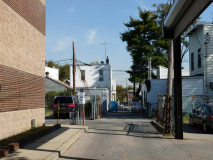














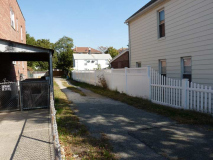






















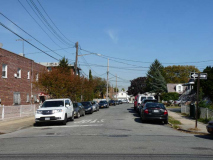




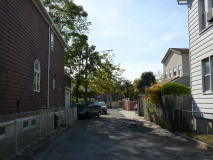



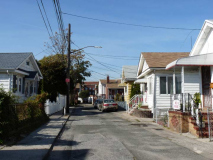
11 comments
I get an “access denied” error message after clicking on the link labeled “GOOGLE MAP: CANARSIE LANES”. The page says I don’t have permission to view it.
Fixed. I wonder what Rhodes scholar at google decided to make Private the default.
What’s with the bent street signs in some of your photos? How does that happen? Could it be some sort of gang marking?
Trucks bash into them
I wonder if those gates, driveways and extended lawns are legal. They may be the result of the city’s inattention rather than a transfer to private ownership.
Structure in last picture looks like it might have been converted from a barn, esp if the area contained farms.
Same thought occurred to me — but Chris F beat me to the draw, by two days!
Regarding the “trolley poles”, actually the trolley pole is the pole on top of the car, these would more properly be called line poles, anyway I think I know why a few have survived in Canarsie. There was a BMT substation located at between Flatlands Av and Ave K at the shuttle right of way; I believe this substation was still in operation until the ’60’s and supplied third rail power to the outer portion of the subway line. I remember the line poles having cables on them at that time. So, while the elevated and trolley operation were long gone, the substation remained in use until replaced by one located along the remaining portion of the line
I had friends that lived on E. 86th Street and they used to take the Remsen Avenue bus all the way to the Utica Ave subway station, Remsen End, thereby bypassing the Rockaway Parkway BMT Canarsie business. They said it made better time to the City…
I worked on digital maps of the Five Boroughs in the early 1990’s and we used to tell newly hired digitizers that the Hagstrom books were useful mostly as copyright traps.
I wish you had stuck with the gorgeous hand drawn maps.